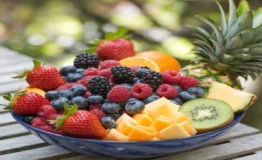Is Crème Brûlée the Same as Custard?
Crème brûlée and custard are two beloved desserts that often confuse dessert enthusiasts. While they share a custard base, their preparation methods, ingredients, and even cultural significance set them apart. This article explores whether crème brûlée is the same as custard, examining the differences, similarities, and what makes each dessert unique.
What is Crème Brûlée?
Crème brûlée is a luxurious French dessert that consists of a smooth, creamy custard base topped with a layer of caramelized sugar. The combination of textures—silky custard beneath a crisp caramelized top—makes crème brûlée a delightful treat for the senses. The name “crème brûlée” translates to “burnt cream,” which refers to the caramelization process that occurs when sugar is torched on top of the custard.
Ingredients and Preparation
The base ingredients for crème brûlée are heavy cream, egg yolks, sugar, and vanilla. The heavy cream gives the custard its rich texture, while the egg yolks provide structure. After combining the ingredients, the mixture is baked in a water bath, which helps ensure even cooking and prevents the custard from curdling. The dessert is then chilled, allowing the flavors to meld and the custard to set. Just before serving, a thin layer of sugar is sprinkled on top and caramelized using a kitchen torch, creating the signature crunchy topping.
A Brief History of Crème Brûlée
The origins of crème brûlée are somewhat disputed, with claims that it originated in both France and England. Some historians trace its roots back to the 17th century, while others argue that similar dishes were made in Spain and other European countries even earlier. Despite its somewhat mysterious history, crème brûlée became a staple of French cuisine, particularly in fine dining establishments.
If you’re interested in the detailed history of crème brûlée, explore the history of crème brûlée.
What is Custard?
Custard, in its simplest form, is a mixture of milk or cream, egg yolks, and sugar, which is thickened by the coagulation of the egg proteins when heated. Custards can be either baked, stirred, or steamed, resulting in varying textures. Baked custards, like flan and crème caramel, tend to have a firm, sliceable consistency, while stirred custards, such as pastry cream and crème anglaise, are smooth and creamy.
Variations of Custard Around the World
Custard is a versatile dessert with many variations across different cultures:
- Crème Caramel: A popular variation in Europe, crème caramel is a baked custard topped with a layer of soft caramel.
- Flan: Common in Latin American cuisine, flan is similar to crème caramel but often includes additional flavors like cinnamon or citrus.
- Pudding: In the UK and the US, custard is often used as a base for puddings or served as a sauce over baked desserts.
- Pastry Cream: A thick, stirred custard used as a filling for pastries, cakes, and éclairs.
- Panna Cotta: Although technically not a custard, panna cotta is a creamy, gelatin-based dessert that often gets compared to custards due to its similar texture.
Custards can be simple or complex, depending on the ingredients and techniques used. You can find custard in everything from simple home-cooked meals to elaborate restaurant desserts. For a deeper dive into custards, check out the different types of custard.
Main Differences Between Crème Brûlée and Custard
While crème brûlée and custard share common elements, there are significant differences in their preparation, ingredients, and overall experience.
Ingredient Differences
- Crème Brûlée: Typically made with heavy cream, egg yolks, sugar, and vanilla. The heavy cream is key to the dessert’s richness.
- Custard: Traditionally made with milk instead of heavy cream, though some variations may use a combination of milk and cream. The choice of dairy affects the texture and flavor, with custard often being lighter than crème brûlée.
Preparation Techniques
- Crème Brûlée: Baked in a water bath to ensure gentle, even cooking, preventing the eggs from curdling. After baking, the custard is chilled, and sugar is sprinkled on top before being torched to create the caramelized crust.
- Custard: Depending on the type, custard can be baked, stirred on the stovetop, or steamed. Baked custards are often served with toppings like caramel, while stirred custards are typically served warm or chilled.
Texture and Consistency
- Crème Brûlée: The texture of crème brûlée is smooth, rich, and creamy, with a slight jiggle when set correctly. The contrast between the soft custard and the crunchy caramelized top adds to the sensory experience.
- Custard: The texture of custard varies based on how it is prepared. Baked custards like flan have a firmer consistency, while stirred custards like crème anglaise are creamy and pourable.
Toppings and Presentation
- Crème Brûlée: The hallmark of crème brûlée is its caramelized sugar topping, which creates a crisp layer that contrasts with the creamy custard underneath.
- Custard: Baked custards are often served plain or with a caramel sauce, while stirred custards may be garnished with fresh fruit, whipped cream, or nuts.
Historical Background: The Evolution of Crème Brûlée and Custard
Custard is one of the oldest known desserts, with roots dating back to ancient Rome. The Romans would mix eggs with milk and honey to create a dish similar to modern-day custard. Over time, custard recipes spread across Europe, evolving into various forms depending on regional ingredients and culinary traditions.
In the Middle Ages, custard was often used as a filling for pastries, pies, and tarts, solidifying its place in European cuisine. By the 17th century, French chefs had refined custard-making techniques, leading to the development of more elaborate custard-based desserts like crème caramel, flan, and crème brûlée.
Crème brûlée itself became popular in France during the 19th century, where it was often served in fine dining establishments. The use of a blowtorch to caramelize sugar on top added a modern twist to the traditional custard recipe, elevating crème brûlée to the sophisticated dessert it is today.
Cultural Significance of Crème Brûlée and Custard
Both crème brûlée and custard hold cultural significance in different parts of the world. Their versatility and simplicity make them accessible, while their rich history and variations keep them relevant in modern cuisine.
- France: Crème brûlée is a symbol of French culinary excellence and is often associated with fine dining. It’s a dessert that is both simple and luxurious, embodying the elegance of French cuisine.
- Latin America: Flan, a popular custard dessert in Latin American countries, is often served at family gatherings and celebrations. It has become a cultural staple, with variations that include different flavors and toppings.
- United Kingdom: In the UK, custard is often used as a sauce for desserts like bread pudding, spotted dick, and treacle tart. It’s a comforting dessert that has been enjoyed for generations.
- Asia: In Japan, purin, a type of caramel custard similar to flan, is a popular dessert often sold in convenience stores and restaurants. Custard-filled pastries, like custard buns, are also common in Asian bakeries.
These cultural differences highlight the adaptability of custard-based desserts, showing how different regions have embraced and reimagined this classic treat.
How to Make the Perfect Crème Brûlée and Custard at Home
Both crème brûlée and custard can be made at home with just a few simple ingredients. Here’s a step-by-step guide for each dessert:
Crème Brûlée Recipe
Ingredients:
- 2 cups heavy cream
- 5 egg yolks
- 1/2 cup sugar (plus extra for topping)
- 1 vanilla bean or 1 teaspoon vanilla extract
Instructions:
- Preheat your oven to 325°F (163°C).
- In a saucepan, heat the heavy cream and vanilla until warm but not boiling.
- Whisk the egg yolks and sugar together in a separate bowl until smooth.
- Gradually whisk the warm cream into the egg mixture, then strain to remove any lumps.
- Pour the mixture into the ramekins, place them in a baking dish, and fill the dish with hot water halfway up the sides of the ramekins.
- Bake for 40–45 minutes until the custard is set but still slightly jiggly in the center.
- Chill the ramekins in the refrigerator for at least 2 hours.
- Before serving, sprinkle sugar over the top of each custard and use a kitchen torch to caramelize the sugar until golden brown.
Custard Recipe
Ingredients:
- 2 cups milk
- 4 egg yolks
- 1/2 cup sugar
- 1 teaspoon vanilla extract
Instructions:
- Preheat your oven to 350°F (177°C).
- In a saucepan, warm the milk over medium heat until steaming.
- Whisk the egg yolks and sugar in a bowl until combined.
- Gradually pour the warm milk into the egg mixture, whisking constantly.
- Pour the mixture into ramekins and place them in a baking dish with hot water.
- Bake for 30–35 minutes until the custard is set.
- Serve warm or chilled, depending on preference.
For more tips on making the perfect crème brûlée, check out this helpful guide to making perfect crème brûlée.
Common Misconceptions: Are They Really the Same?
There are several misconceptions when it comes to comparing crème brûlée and custard. Here are a few common myths:
Myth 1: Crème Brûlée is Just Custard with a Sugar Topping
While it’s true that crème brûlée starts with a custard base, the addition of heavy cream and the unique caramelized sugar topping make it a distinct dessert. The use of a kitchen torch to achieve the crispy sugar crust adds a layer of complexity and texture that sets it apart from other custard-based desserts.
Myth 2: Custard is Always Baked
Custard can be prepared in several ways, not just baked. For example, crème anglaise is a stirred custard that is cooked on the stovetop. The method of preparation depends on the desired outcome, whether it’s a firm baked custard or a creamy, pourable sauce.
Myth 3: All Custards Are the Same
Custard is a versatile dish with many variations. Crème brûlée, flan, pudding, and crème caramel are all different types of custard, each with its own unique characteristics. The differences lie in the ingredients, preparation methods, and final presentation.
FAQs: People Also Ask
Is crème brûlée a type of custard?
Yes, crème brûlée is technically a type of custard. It’s made with a custard base of eggs, sugar, and cream, which is then baked and topped with caramelized sugar.
Can I use custard to make crème brûlée?
While you can use a custard recipe as a base, the key to crème brûlée is the caramelized sugar topping, which requires a kitchen torch or broiler to achieve the signature crunchy layer.
What makes crème brûlée different from other custards?
The primary difference lies in the ingredients and the method of preparation. Crème brûlée uses heavy cream instead of milk, giving it a richer texture, and the caramelized sugar topping adds a unique layer of crunch.
Is flan the same as crème brûlée?
No, flan is a baked custard with a soft caramel topping, while crème brûlée features a crunchy caramelized sugar topping. The textures and flavors are quite different, although they share a custard base.
Which is healthier: Crème brûlée or custard?
Custard is generally lighter in calories because it often uses milk instead of heavy cream. If you’re looking for a lower-calorie option, traditional custard may be the healthier choice.
Conclusion: A Deeper Look into the Differences Between Crème Brûlée and Custard
At first glance, crème brûlée and custard might seem similar due to their shared use of basic ingredients like eggs, sugar, and dairy. However, as we’ve explored in this article, there are several key differences that distinguish these two desserts. Crème brûlée, with its rich and creamy texture, owes much of its luxurious mouthfeel to the use of heavy cream instead of milk. Additionally, the iconic caramelized sugar topping, achieved through torching, adds a layer of texture and flavor that sets it apart from other custards.






